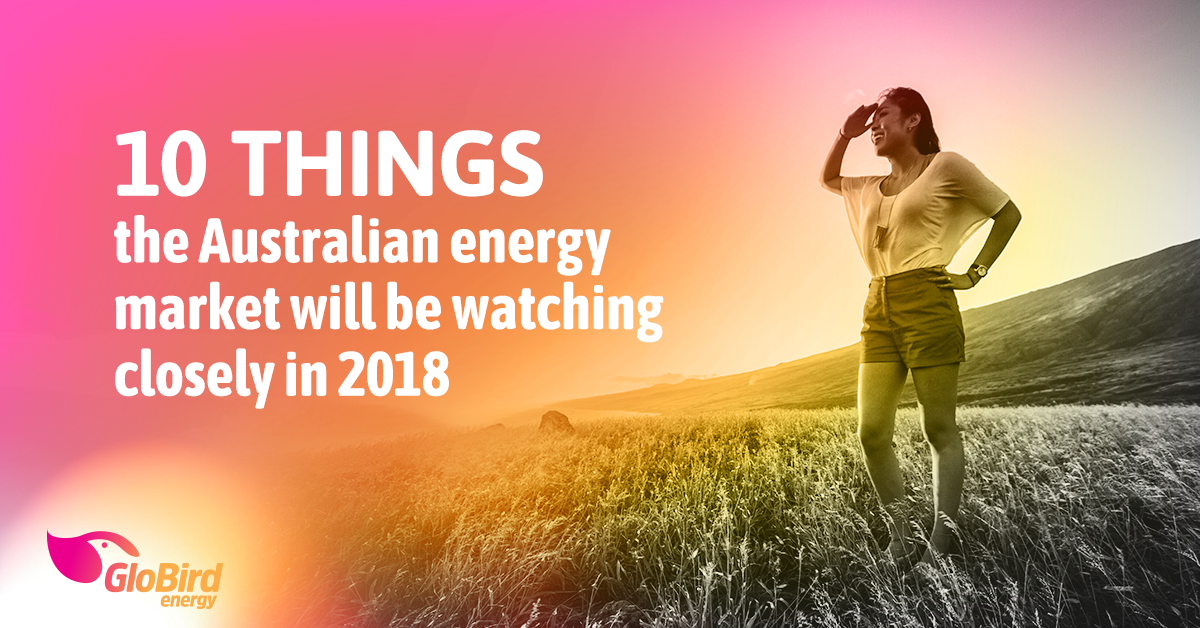In our last post, we looked back at some of the things that had a major impact on the Australian energy market in 2017. This time, we’re looking forward.
We think we have a reasonable idea about some of the things we can expect to see in 2018 … but for others, we’ve had to polish the crystal ball a bit.
One thing we wish we could be more confident about is that the new year will be less volatile than the old one!
- We start 2018 as we did 2017, a little anxious about how the grid will perform on the hottest days of summer, particularly if high temperatures are widespread and last for several days. AEMO (the Australian Energy Market Operator) has already contracted more than 1,000 MW under the Reliability and Reserve Trader provisions. Despite everyone’s best efforts, fingers are crossed that blackouts will be avoided this summer.
- More consumers are likely to change the way they interact with energy retailers, whether that’s changing plans, changing suppliers, or simply changing the way they pay their bills. This will be facilitated by Power of Choice, a package of reforms to the NEM designed to give consumers more options and control of the way in which they use and manage their electricity expenditure, which came into effect on December 1.
- The ACCC’s final report of its Retail Electricity Pricing Review is likely to shape the way forward for some time. We think most of those involved in the electricity industry (as well as governments and regulatory bodies) respect the fact that the ACCC is doing a particularly comprehensive job of gathering real, relevant data, as well as speaking to a wide range of people with a variety of perspectives and experiences. The report is due mid-year.
- The Energy Security Board (ESB) will finalise the design of the National Energy Guarantee (NEG) by March. How the Reliability Guarantee and Emissions Guarantee take shape will play a big part in how a number of companies in the energy sector do business in the future.
- The next COAG (Council of Australian Governments) Energy Council, in April, is likely to see some interesting discussions. For one thing, the design of the NEG will be tabled there, but there are also likely further discussions about domestic gas supply and Snowy Hydro.
- We’ll be very interested to see which energy-related issues are given the greatest emphasis by the two major parties in the three state elections coming up in 2018: South Australia’s in March, Tasmania’s in May, and Victoria’s in November. If there are any supply issues this summer (as there were last) resulting in blackouts, the South Australian election is sure to focus even more intently on the policies of the current government.
- The big energy generation companies will continue to explore and plan for life after coal-fired power stations. AGL has set the agenda, to some degree, by announcing that it plans to replace the coal-based electricity generation which will be lost by the closure of the Liddell power station in 2022 with a mix of gas, wind, and solar-generated electricity.
- The trend toward people power, with Australia having the highest penetration of household rooftop solar in the world, is likely to increase. Not only are more consumers than ever before aware of what’s possible, but they’re more motivated than ever to find ways to cut their bills. Couple that with the fact that storage batteries are becoming more viable, and it all points to people taking greater control of their own power generation and usage.
- Technology will also play a greater role in energy management, particularly on a personal level. Now that people are aware that they can be rewarded for using less power during peak times, we expect more people to more closely monitor their electricity consumption via the various apps that are already available, and we wouldn’t be surprised to see further innovation in this area of personal and household energy management.
- There will be some sort of breakthrough in renewable energy, whether it comes right out of left field – like being able to charge your personal devices using mould from bread (yes, this is a real thing!) – whether it’s one of the solar energy innovations we wrote about a couple of weeks ago, or whether it’s in wind, thermal, or wave power, there are so many scientists and researchers (with substantial funding) working to discover and perfect the next big thing in energy, chances are something will happen.
In summary, we’re happy to see that the Australian energy market has a lot going on, because it’s all in response to lessons learnt and issues that have come to light over the past few years.
It all promises to move us forward in a measured, sensible, and sustainable way, even if it might take another 12 or 18 months to start to see the results, both in terms of lower prices for consumers and improved energy security for all.
We’ll conclude with this note:
The Australia Energy Market Commission (AEMC) has forecast that around 5.3 gigawatts of new power will come online between 2016-17 and 2019-20 – about 4.9 gigawatts of which will be renewable generation – which will help drive down energy costs in the medium-term.
Happy New Year.
